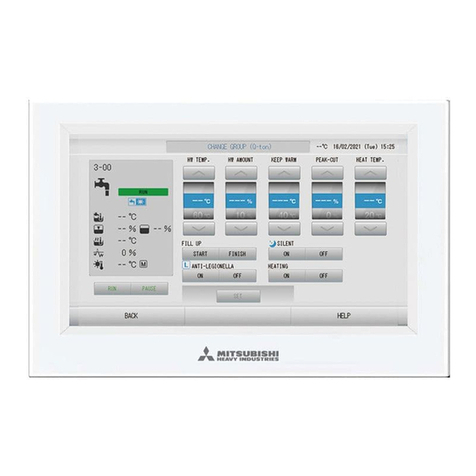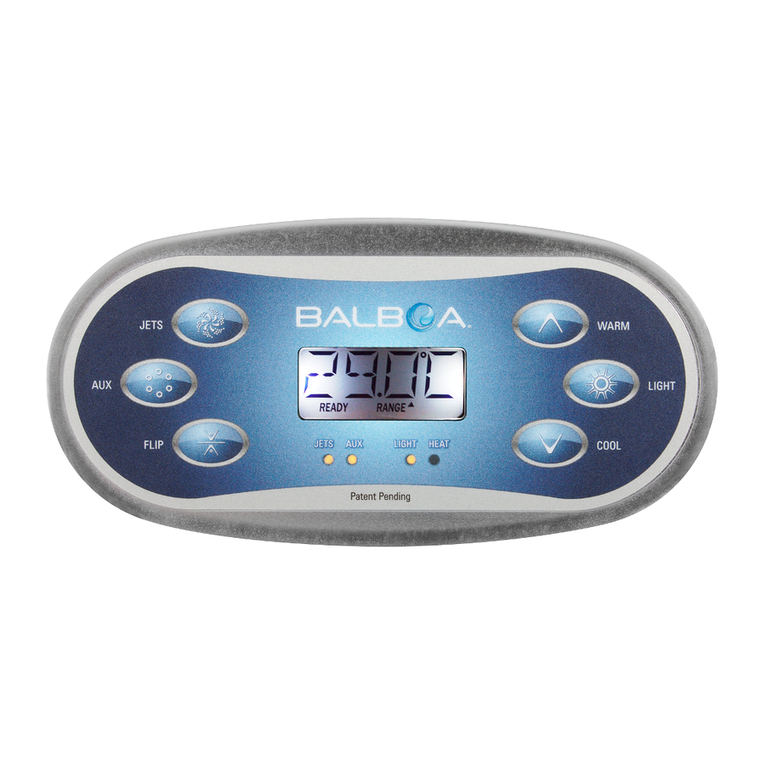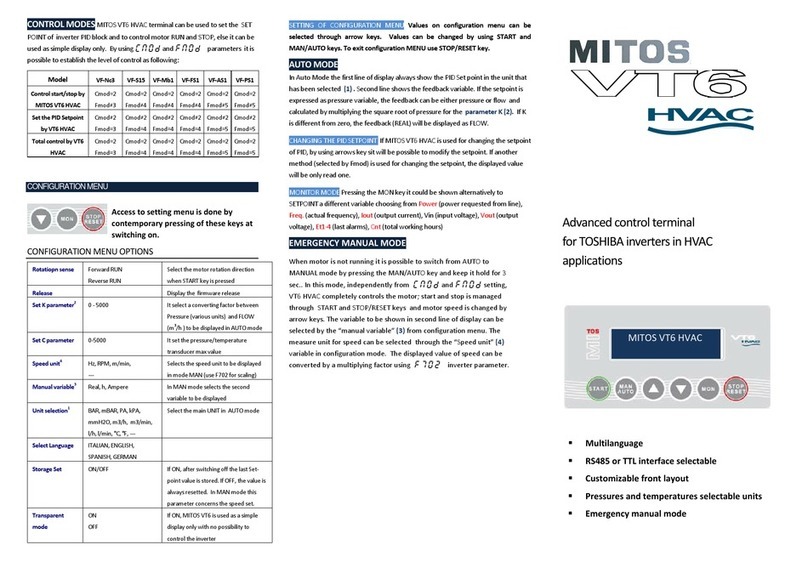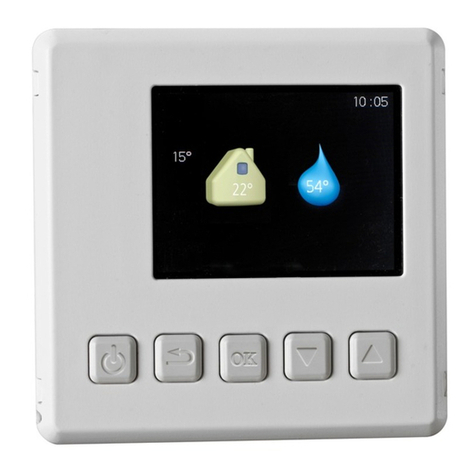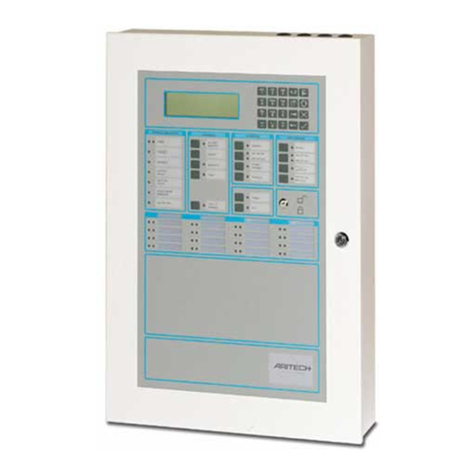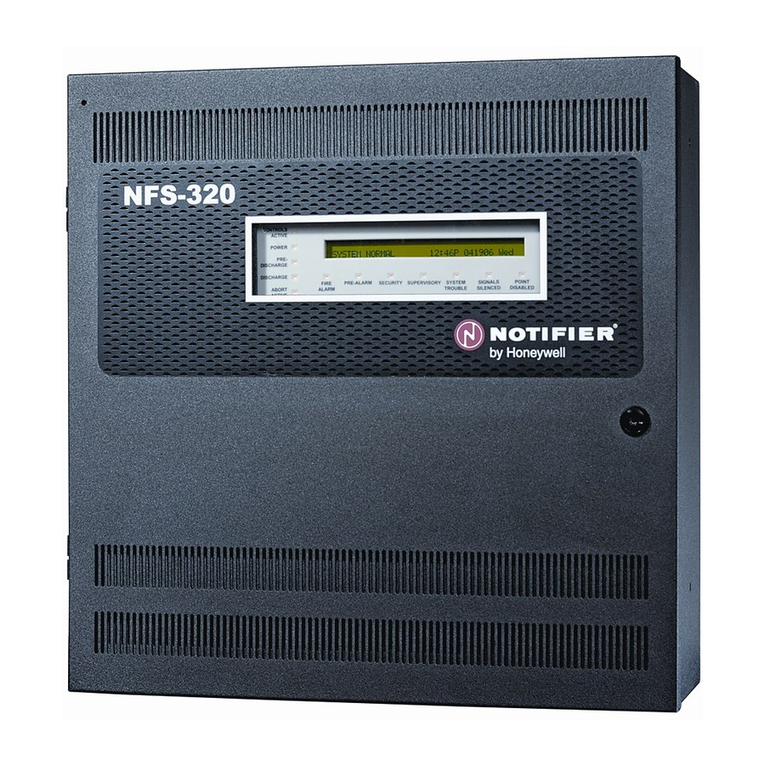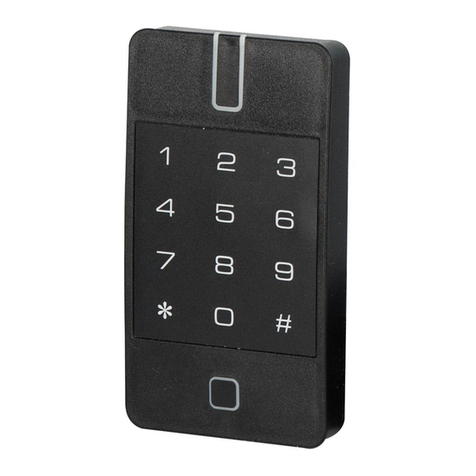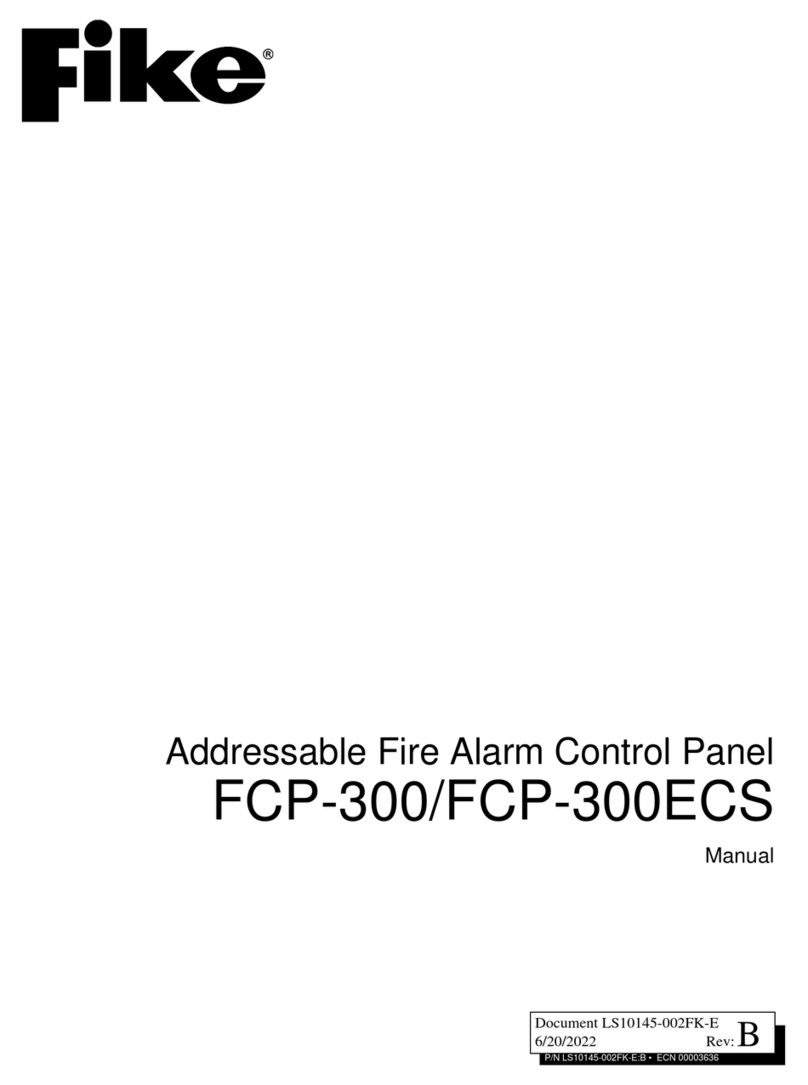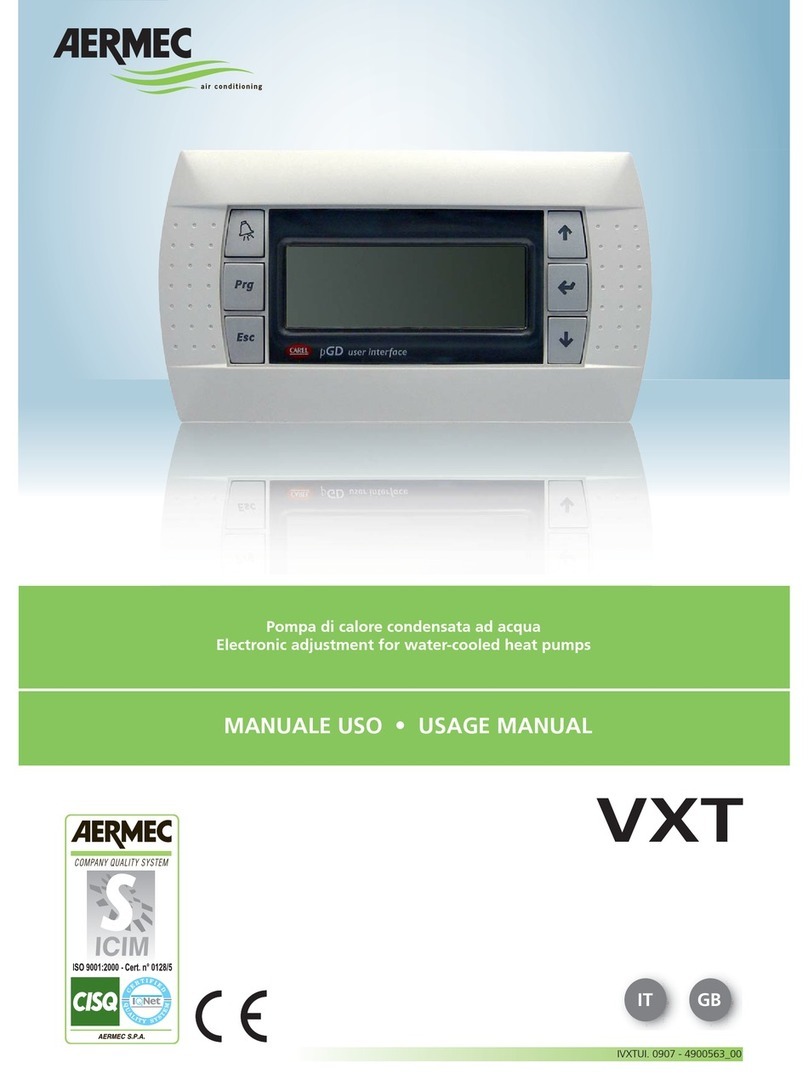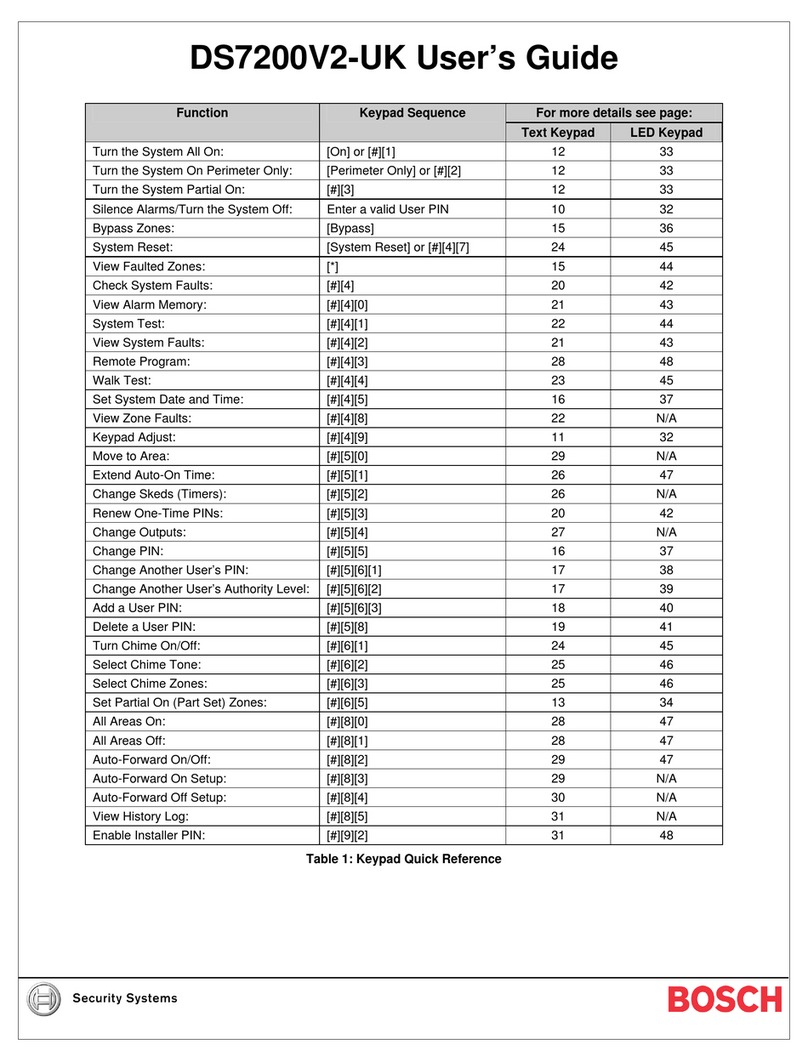Sur-Gard SG-DV4420 User manual

1
INTRODUCTION
The Sur-Gard model SG-DV4420 is a combination of
Fire control panel and SCHED-3A communicator. This
fire transmitter consists of six channels: Two class-A
alarms A1 and A2, one End of line resistor supervisory
input S1, and three closed loop supervisory S2, S3 and
S4. There is also one programmable output, an AC fail,
and a low battery detector. The SG-DV4420 can transmit
up to ten codes to the MLR2 receiver at the central
station. It includes the 12V power supply/battery charger
and the 24V power supply for the F1/F2 modem. The
standby power is obtained from a 12V battery.
The EEPROM programming is done easily and quickly
by using the SUR-GARD SG-DVT1 SCHED-3A tester. It
is only necessary to enter the account ID and options
needed. Other data such as the function bytes, delays,
etc. can be modified to meet different operating conditions.
STAND-ALONE MODE
SG-DV4420B mounted in Multi 2XF metal cabinet with
built-in 115 to 14VAC transformer, meeting ULC
requirements as a Stand-Alone fire/sprinkler transmitter.

2
SYSTEM OVERVIEW
The SG-DV4420 is intended for use as a fire transmitter
only, for connection to a sprinkler riser or to output relay
contacts of an existing fire alarm control panel. This unit
does not include U.L.C. requirements for a complete
building fire alarm system such as multi-zone with alarm
and trouble indicators.
INPUTS
• 2 Class A zones
• 1 ELR supervisory zon
• 3 Normally closed Supervisory zones
OUTPUTS
• Power supply Vaux 12V at 250mA w/15 Ah
battery 24V at 50mA output to power modem
• Operation controlled through program options
• 1 Programmable output PGM 1: Switched to
ground with current limiting resistor
ELECTRICAL SPECIFICATIONS
MAXIMUM LOOP RESISTANCE PER CONDUCTOR
Class-A loops
A1, A2 – 100 ohms
Supervisory loops
S1 – 2700 ohms ELR +/- up to250 ohms
S2,S3,S4 – 500 ohms.
Eprom part number: Type 27C256.
Nominal current draw: 260mA with fully charged
battery and F1/F2 subset
powered.
Battery Required: 6.5 Amp hr minimum to 15
Amp hr rechargeable gel-cell
or sealed lead-acid battery
mounted in panel.
TRANSFORMER
Built-in, 16,5 Vac, 37VA Class 2 Transformer.
Dimensions: 29cm(W) x 35.5cm(H) x 12.5cm(D)
Weight: 3.7Kg
FEATURES
POWER SUPPLY
The SG-DV4420 has a built-in 12VDC to 24VDC
regulated converter power supply, to operate the F1F2
subset modem, a one Amp 12VDC power supply and
battery charger. The auxiliary power supply can be used
to power smoke detectors and other devices requiring
12VDC. 800mA 12VDC is available from the AUX
(positive) and GND (negative) terminals. It also includes
AC failure and low battery detector.
EEPROM NON-VOLATILE MEMORY
The EEPROM non-volatile memory is used to store the
programmable data needed for each installation such
as the ID code, the all call response, etc...
SERIAL OUTPUT
The serial output to the F1F2 subset modem is on a 6
position modular jack. A 6 foot modular cable is supplied
with the unit.
LOW BATTERY DETECTION
When the battery voltage falls below about 11V, this
internal circuit will be activated and the programmed
low battery code will be transmitted to the central station.
WATCH DOG CIRCUIT
The Watch Dog reset circuit continously monitors the
operation of the microprocessor. If a malfunction occurs
(due to lightning or other unusual event) this circuit will
restart the microprocessor in less than 10 seconds.
LOW BATTERY DISCONNECT CIRCUIT (NOT
ON BOARD ONLY VERSION)
If the battery voltage fall below about 10.5V, the system
will electrically disconnect the battery to prevent it from
being deep discharged. The system remains disconnected
from the battery until the AC power comes back ON or
until the dead battery is replaced with a sufficiently
charged battery.
CLASS A FIRE ZONES: “A1” & “A2”
The Fire zones A1 and A2 are supervised (normally
open alarm initiating contacts) Class A circuits designed
to accept sprinkler switches, manual pull stations, building
fire alarm control panel, alarm output relay contacts or
latching four-wire smoke detectors.
Circuit A1 has an “retard” activation delay. On alarm,
(fire loop shorted) once the activation delay has expired,
the alarm is transmitted to the central station. The “retard”
activation delay is programmed at location 21. If the fire
input A1 returns to normal or swings before the activation
delay has expired, there will be no transmitted alarm.
This activation delay feature makes it possible to use
vane type waterflow switches without false alarms from
pressure surges. There is also a restore delay time
programmable at location 22, to avoid nuisance repeat
alarms.

3
SOFTWARE SPECIAL FEATURES
EASE OF PROGRAMMING
The system ID code and other programmable parameters
will be downloaded into the module EEPROM by using
the SG-DVT1 Tester (with program version 5.0 or later)
as an access terminal. The SG-DVT1 is plugged into
the SCHED-3A line modular socket.
SELECTION OF TRANSMISSION
It is possible to select, for each zone, no transmission,
alarm transmission only or alarm and restore transmissions.
ACTIVATION AND RESTORE DELAYS
The loop A1, Low Battery detect and the AC fail detect
have programmable activation and restore delays to
reduce false alarms and nuisance troubles.
BELL OUTPUT FUNCTION ON PROG. OUTPUT #1
The PGM OUT can be activated by alarm on A1 only,
A2 only or both. It has a 17 minute autoreset.
LINE TROUBLE WARNING
If the transmission line were cut; the unit would give a
2 seconds pulse to the PGM OUT output after a
programmable delay of 60 sec. or 120 sec.
The A1/A2 Class A Fire/Sprinkler circuits must have
one closed loop between its two + terminals and another
between its two - terminals. Opening one of those loops
will cause a fire trouble and shorting across the loops will
cause a fire alarm.
SUPERVISORY INPUTS:“S1”,“S2”,“S3”,& “S4”
There are four supervisory circuits provided, which may
be used to monitor other parameters such as main
valve and\or pressure. The first supervisory loop, S1, is
an End of Line Resistor loop. The supervisory loop S1
must have a 2.7K end of line resistor.This is not a Class
B fire circuit, since either a short or an open circuit
condition causes the same supervisory signal.The
supervisory loops S2, S3 and S4, are used for normally
closed switch contacts.
PROGRAMMABLE OUTPUT: "PGM OUT"
The SG-DV4420 has one programmable output, switching
to negative, with a 150 ohm 1W current limiting resistor.
A sensitive relay (with a coil resistance of 700 ohms or
more), a buzzer, a LED or compatible DC operated
device may be connected between the AUX (positive)
terminal and the PGM OUT (switched negative) terminal
on the main board. Typical uses are: control relay, alarm
on A1 and/or A2 indicator, line trouble warning indicator,
or “Ring Back” (call received confirmation).
The operation of the Programmable Output depends
upon which option is selected in the programming table.
See the Programming Guide for a list of programmable
operation possibilities programmed at Location 27. The
programmable output can also be controlled remotely
from the receiver.
SELECTION JUMPERS
The program selection jumper must be left open.
ON BOARD LED INDICATORS (SEE FIG. #1)
WATCH-DOG: Flashes once every 10 seconds to show
unit is functioning normally. Any other flashing period
indicates a malfunction in the unit.
TX LINE: Flashes when unit transmits data.
RX LINE: Flashes following incoming data.
A1 FIRE/TROUBLE: Light ON when zone A1 in alarm
or in trouble.
A2 FIRE/TROUBLE: Light ON when zone A2 in alarm
or in trouble.

4
INSTALLATION
running close to it, to avoid electrical noise causing
disturbance to the components.
You can use up to 5 SG-DV4420 on 1 F1/F2 subset
provided they are in the same location or 1 SG-DV4420
and 1 other subscribers control such as SG-DV1660, by
using the SUR- GARD SG-DS1 module (Y connector).
You have to connect together the 24V negative terminals
of both units, separate the ID codes and program a
different all call select for each one.
F1/F2 SUBSET
1. Remove power to the F1/F2 subset by unplugging the
A.C. adaptor from the 120 VAC outlet (if installed).
Do not remove the plug from the “Adapt" input of the
F1/F2 subset while the adaptor is powered as it may
cause an arc at the input and damage the F1/F2 subset.
2. If the telephone company installed a cable on the
"Terminal" input of the F1/F2 subset, disconnect it
and connect the 6 pin modular cable MCBL6 (6 ft.)
included with the SG-DV4420. Then connect the cable
to the SG-DV4420 Fire Transmitter. A custom length
6 pin modular cable(MCBL-C) is also available on
special order from Sur-Gard. The custom cable is
available in any length up to the maximum run length
of 50 feet. See the "F1/F2 Subset Connections" diagram
on page 10.
3. The F1/F2 subset should be installed close to the
control panel. However, if it is impossible, follow
these precautions:
• Avoid cable runs close to noise generators like
power transformer, motor, fluorescent tube, etc...
• If you can’t avoid this, or the F1/F2 subset is too
far from the control panel, it is necessary to use
low capacitance shielded cable to connect the
F1/F2 subset to the control panel.
RECOMMENDED MAXIMUM WIRE RUN
The RS-232 communication (Rx & Tx) has a
recommended maximum wire run of 50 feet, using Sur-
Gard's 6 pin modular cable.
The power supply (24Vdc) has a recommended maximum
wire run of 100 feet using:
• #18 awg unshielded 4 conductor cable
• #22 or #24 awg unshielded 4 conductor cable with
2 wires connected in parallel for each of the 24VDC
Connections.
FOR LONGER DISTANCES
For RS-232 communication distances greater than 50 feet,
shielded cable with Sur-Gard's SG-DS1 connectors at
each end must be used. One SG-DS1 has to be installed
inside the Fire Transmitter cabinet and another one inside
the F1/F2 subset box, (see Appendix B for theSG-DS1
wiring diagrams). The maximum distance maybe extended
by using a shielded cable such as those described below.
BENCH TESTING
The SG-DV4420 contains factory default programming.
Any additional programming required is done through
the SG-DVT1 tester. For many applications all that will
be required is to enter the ID number. If you need help,
talk to your Sur-Gard distributor.
Program the SG-DV4420 using the SG-DVT1 Tester
(with program version 5.0 or later) as an access terminal.
The SG-DVT1 is plugged into the SCHED-3A line modular
jack. The program select jumper J2 should be removed
from the SG-DV4420 circuit board.
Connect a 2.7K end of line resistor between the S1 input
terminal and the GND terminal. Connect a jumper on each
normaly closed supervisory zone S2, S3 and S4 input.
Connect 2 loops to the A1 and A2 Sprinkler/fire class A
input terminals - out to - in , and + out to + in. To
completely test your Fire system including the communicator
data, it is necessary to connect the unit to a test set, such
as the SG-DVT1 (see system testing procedure).
Connect a 14Vac, 20VA transformer to the AC terminals.
Before plugging in the transformer, be sure the circuit
board is not resting on anything metallic which may
cause a short.
NOTE: The SG-DV4420 will not start up if AC is OFF
and the battery is low.
MOUNTING THE PANEL
Select a dry location, close to an unswitched AC source,
close to a ground connection, and close to the F1/F2
subset (modem) location.
Remove the printed circuit board and mounting hardware
from the cardboard retainer inside the panel. Before
attaching the cabinet to the wall, press the five white
nylon printed circuit board mounting studs and the ground
connection screw into the cabinet from the back.
Pull all the cables into the cabinet and prepare them for
connection before mounting the circuit board to the
back of the cabinet. Press the circuit board down onto
the mounting studs.
With power off, wire the DV4420 as shown on fig. #1. All
normally closed (N/C) loops require a jumper if not used.
The connections to the F1/F2 subset are shown on fig.
#2. Avoid running the cable close to noise generators
like power transformer, motor, fluorescent tube, etc...
HOOK-UP PROCEDURE
DO NOT connect the transformer or battery until all other
wiring has been connected (See power-up procedure).
Connect a ground cable from the cabinet ground connection
by the shortest and most direct route to a grounding rod
and to the Earth Ground Terminal on the panel.
Connect zone cables to zone loop inputs and put jumpers
or end of line resistors as required on any unused zones.
Connect wires supplying power to detectors to the auxiliary
supply. Make sure that the PC board is clear of wire

5
If the transmitter is not communicating (no signal on Rx
led of transmitter) to the central station at this point, call
the telephone Company and ask them to make sure
that the “Leg” is on. The telephone company will ask
you for the circuit number and the leg number which
can be found along with the service telephone number
on a card fixed on the F1/F2 subset.
REQUIREMENTS FOR ULC
INSTALLATION APPROVAL
• All components used in the system (contacts, detectors,
etc...) must be ULC listed.
• Wire the transformer to the A.C. line according to the
electrical code on a separate circuit breaker.
• The F1/F2 subset should be placed in a metal box,
(for example the SUR-GARD SG-UMBX1) close to
the control panel.
• The battery must have a minimum ampere hour
capacity of 6.5AH. In case of long time power failure,
the control panel must function normally for 24hrs.
NOTE: Refer to ULC Standard booklet “FIRE ALARM
CERTIFICATE SERVICE OF UNDEWRITER’S
LABORATORIES OF CANADA”. You can
contact ULC at Toronto for more information
or to obtain the booklet.
CONTROL POINT INFORMATION
Control point #1: programmable output PGM OUT
The control point #1 can be activated remotely from the
receiver. This is done by sending a command containing
the subscriber unit ID, which identifies to which unit the
command message is addressed and the point ID which
identifies the control point.
Point ID bytes are split into 2 digits. The first digit specifies
the type of command and the second digit indicates
which control point is to execute the command (on the
DV4420, the control point is always #1). The point ID
byte start with a letter from A to D, giving the desired
output function, as follows:
A. Turn On the specified point.
B. Turn Off the specified point (stop).
C. Turn On for 2 seconds (Pulse) the specified point.
D. Flash the specified point, 2 seconds On, 2 Seconds
Off, until a command is received to stop (B).
When a new command is received, for the programmable
output (control point #1), it replaces the command
previously in effect, if any.
Control point #1 can be activated internally (locally) by
the unit, for an “on time” of 2 seconds, when the SG-
DV4420 receives the “Kiss OFF” character from the
receiver. The “Kiss Off” character is sent by the receiver
as a confirmation signal that the last change of status
message from the SG-DV4420 was correctly received.
This output command takes priority over any command
that output point was already executing.
A. For 50 feet to 100 feet
• Use #18 awg shielded 4 conductor cable such
as Provo (Cat. Num. 1782-21) or Belden (Cat.
Num. 9814).
• #22 or #24 awg shielded 4 conductor cable.
B. For 100 feet to 500 feet
Use Low Capacitance #24 awg shielded 4 conductor
cable such as ALCATEL (Cat. Num. 371-02-24), Provo
(Cat. Num. 6652-21), or Belden (Cat. Num. 9927) for
the RS-232 communication (Rx, Tx, and SG).
You must also use a 24Vdc power supply (such as
Sur-Gard's SG-2415 24Vdc power supply) close to
the F1/F2 Subset to power it. Make sure to run a
wire (#18 or two #24 awg wires in parallel) between
the negative 24Vdc terminal of the Fire Transmitter
and the power supply, so that they are connected
together.
POWER-UP PROCEDURE
Before applying power to the SG-DV4420 or the F1/F2
subset, connect the 24V output to the “Batt” input of the
F1/F2 subset.
Connect the tansformer, wait approx. 5 seconds. Check
that A1 and A2 loop status led lights are off and the
green “A.C. POWER” led is on. If a led(s) does not turn
off, find the cause (such as loop open or shorted) and
correct it. If the “A.C. POWER LED” is off, find the cause
(such as breaker turned off) and correct it.
NOTE: To supply AC power to the SG-DV4420, the
transformer should not be connected to an
outlet that is controlled by a switch.
Check for the WATCH-DOG led pulses. This led indicator
flashes once every 10 seconds to show unit is functioning
normally. Activate a zone to be sure that the panel is
responding to signals. If the panel does not respond
and there are no indicators on, check that the wiring is
correct. If the panel is responding normally, connect the
battery. The red battery lead attaches to the positive
battery post and the black battery lead attaches to the
negative battery post.
SYSTEM TESTING
First test the system thoroughly using an SG-DVT1 tester.
Contact the monitoring station to request a transmission
test before connecting the 6 pin modular cable to the
modem. Trip an alarm on any loop. Wait for the
communication to complete and check with the monitoring
station to confirm the transmission. You can use the Rx/
Tx Led indicator to see if the transmitter receives or
transmits. Perform additional transmissions required by
the monitoring station.
The system should be tested on batteries only and AC
only, to be sure that both supplies are present and
adequate. Make sure that the AC Power to the unit is
connected to a separate, well marked, circuit breaker
which will not be turned off by accident.

6
SG-DV4420 WIRING DIAGRAM
NOT
USED
14VAC, 20VA
14V14V
14V14V
14VACAC
ACAC
AC,

7
F1/F2 SUBSET CONNECTION DIAGRAM

8
SG-DVT1 CONNECTION DIAGRAM

9
PROGRAMMING - GETTING STARTED
When the connection is established the SG-DV4420
will identify itself on the display as follows:
PROGRAMMING MODEPROGRAMMING MODE
PROGRAMMING MODEPROGRAMMING MODE
PROGRAMMING MODE
and
SG-DV4420 V1.0SG-DV4420 V1.0
SG-DV4420 V1.0SG-DV4420 V1.0
SG-DV4420 V1.0
CONNECTING...CONNECTING...
CONNECTING...CONNECTING...
CONNECTING... ... CONNECTED... CONNECTED
... CONNECTED... CONNECTED
... CONNECTED
At this point the connection is complete and the SG-
DV4420 is ready to accept programming commands
from the SG-DVT1. The SG-DVT1 is in programmer mode
and will prompt you with the following message:
Prog. all data ?Prog. all data ?
Prog. all data ?Prog. all data ?
Prog. all data ?
YES NO EXITYES NO EXIT
YES NO EXITYES NO EXIT
YES NO EXIT
ENT SEL1 SEL2
At this message you can select if all data needs to be
programmed (press [ENT] to go in the programming all
data mode) or just selected few (press [SEL1] to go in
the programming selected data mode). You may also
select EXIT option to quit programmer mode by pressing
the [SEL2] button.
PROGRAMMING ALL DATA MODE
Press [ENT] to programm all data.
Prog. all data ?Prog. all data ?
Prog. all data ?Prog. all data ?
Prog. all data ?
YES NO EXITYES NO EXIT
YES NO EXITYES NO EXIT
YES NO EXIT
ENT SEL1 SEL2
When [ENT] is pressed to select YES, the SG-DV4420
will ask if you want to reset all data to defaults with the
following message:
Reset ALL Data ?Reset ALL Data ?
Reset ALL Data ?Reset ALL Data ?
Reset ALL Data ?
NO YES EXITNO YES EXIT
NO YES EXITNO YES EXIT
NO YES EXIT
ENT SEL1 SEL2
Press [ENT] if reset to defaults is not required or press
[SEL1] to reset data to defaults. You may also select
EXIT option to return to the programmer mode by
pressing the [SEL2] key.
If you press [SEL1], then the SG-DV4420 will prompt
you to go ahead with reset to factory defaults with the
following message:
ARE YOU SURE ?ARE YOU SURE ?
ARE YOU SURE ?ARE YOU SURE ?
ARE YOU SURE ?
NO YES EXITNO YES EXIT
NO YES EXITNO YES EXIT
NO YES EXIT
ENT SEL1 SEL2
Press [SEL1] to confirm or press [ENT] or [SEL2] to abort
the operation. If you press [ENT], the SG-DV4420 will go
to the Programming All Data Mode. If you press [SEL2],
the SG-DV4420 will return to the programmer mode. If
[SEL1] is pressed, the SG-DV4420 will prompt you with
the following message if the operation was aborted:
Writing FactoryWriting Factory
Writing FactoryWriting Factory
Writing Factory
and
Writing COMPLETEWriting COMPLETE
Writing COMPLETEWriting COMPLETE
Writing COMPLETE
Defaults, WaitDefaults, Wait
Defaults, WaitDefaults, Wait
Defaults, Wait
S1=DIG1 S2=DIG2S1=DIG1 S2=DIG2
S1=DIG1 S2=DIG2S1=DIG1 S2=DIG2
S1=DIG1 S2=DIG2
ADDR=00 DATA=0ADDR=00 DATA=0
ADDR=00 DATA=0ADDR=00 DATA=0
ADDR=00 DATA=011
11
1
The SG-DV4420 has it’s own EEPROM which is used
to keep in memory all the installer programming and
that won’t erase in case of power failure.
All programming must be done according to the
standards and requirements of the central station to
which this equipment is connected, and according to
the restrictions of Underwriters' Laboratories of
Canada, if applicable.
The system ID code and other programmable parameters
can be changed in the EEPROM by using the SG-DVT1
Tester (with program version 5.0 or later) as an access
terminal. The SG-DVT1 is plugged into the SCHED-3A
line modular socket. The program select jumper J2 should
be temporarily removed.
TRANSFER OF DEFAULTS TO THE EEPROM
(Hardware Reset of EEPROM to Factory Defaults). Use
the following procedure:
1. Power down the SG-DV4420 by removing both AC
and battery power.
2. Using a Plug-In jumper borrowed from J2, short pins
marked EEPROM RESET J1 together.
3. Power up the SG-DV4420 and wait approx. 5 seconds.
4. Remove the Plug-In jumper.
PROGRAMMING WITH THE SG-DVT1
Connect a SG-DVT1 (version 5.0 or more) to the SG-
DV4420 (see figure #3). Unplug the modular cable
connected to modem and connect it to SG-DVT1
transmitter jack (XTR).
Power up the SG-DVT1 Tester by connecting it to the
control panel battery using the two alligator clip (make
sure to respect the right polarities).
At the power up the SG-DVT1 display shows:
SELECT MODE V5.0SELECT MODE V5.0
SELECT MODE V5.0SELECT MODE V5.0
SELECT MODE V5.0
NOW: SCAN MODENOW: SCAN MODE
NOW: SCAN MODENOW: SCAN MODE
NOW: SCAN MODE
ENT SEL1 SEL2
Select the “PROG MODE” on the SG-DVT1 by Pressing
[SEL1] twice. The SG-DVT1 screen should be as follows:
SELECT MODE V5.0SELECT MODE V5.0
SELECT MODE V5.0SELECT MODE V5.0
SELECT MODE V5.0
NOW: PROG MODENOW: PROG MODE
NOW: PROG MODENOW: PROG MODE
NOW: PROG MODE
START PROGRAMMER MODE
Press [ENT] to start the programmer mode. The SG-
DVT1 will initiate the handshake with the SG-DV4420.
SELECT MODE V6.0SELECT MODE V6.0
SELECT MODE V6.0SELECT MODE V6.0
SELECT MODE V6.0
NOW: PROG MODENOW: PROG MODE
NOW: PROG MODENOW: PROG MODE
NOW: PROG MODE
ENT SEL1 SEL2

10
At this screen the cursor will be flashing at data digit 2.
Press [SEL1] to increment the first digit of data or press
[SEL2] to increment the second digit of data. Once the
desired data value is reached press [ENT] to accept the
change in data value. The SG-DV4420 will refresh the
display for the next address. The SG-DVT1 will display
“continue programming ?” prompt if no data is changed
for two consecutive addresses.
Continue Prog. ?Continue Prog. ?
Continue Prog. ?Continue Prog. ?
Continue Prog. ?
YES REDO EXITYES REDO EXIT
YES REDO EXITYES REDO EXIT
YES REDO EXIT
ENT SEL1 SEL2
Press [SEL1] to redo the last address or press [ENT] to
continue with the next address. You may also select
EXIT option to return to the tester mode by pressing the
[SEL2] key.
PROGRAMMING SELECTED DATA MODE
Prog. all data ?Prog. all data ?
Prog. all data ?Prog. all data ?
Prog. all data ?
YES NO EXITYES NO EXIT
YES NO EXITYES NO EXIT
YES NO EXIT
ENT SEL1 SEL2
If you select “NO” by pressing [SEL1] at this prompt, the
SG-DV4420 will allow you to select an address:
SELECT ADDRESS:SELECT ADDRESS:
SELECT ADDRESS:SELECT ADDRESS:
SELECT ADDRESS:
ADDR=0ADDR=0
ADDR=0ADDR=0
ADDR=000
00
0
At this screen the cursor will be flashing at address
digit 2. Change the address to the desired address by
pressing [SEL1] to increment the first digit of address
or [SEL2] to increment the second digit of address.
Once the address is selected, press [ENT] and the
current data at that address will show:
SELECT ADDRESS:SELECT ADDRESS:
SELECT ADDRESS:SELECT ADDRESS:
SELECT ADDRESS:
ADDR=00 DATA=0ADDR=00 DATA=0
ADDR=00 DATA=0ADDR=00 DATA=0
ADDR=00 DATA=011
11
1
The flashing cursor will indicate that you can change
the data now. Change the data to the desired data by
pressing [SEL1] to increment the first digit of data or
[SEL2] to increment the second digit of data. Once the
desired address value is reached, press [ENT] for the
SG-DV4420 to accept the change in address value. The
SG-DV4420 will refresh the display for the next address.
If no address or data is changed for two consecutive
addresses then the SG-DVT1 will prompt you if to
continue programming as follows:
Continue Prog. ?Continue Prog. ?
Continue Prog. ?Continue Prog. ?
Continue Prog. ?
YES REDO EXITYES REDO EXIT
YES REDO EXITYES REDO EXIT
YES REDO EXIT
ENT SEL1 SEL2
Press [SEL1] to redo the last address or press [ENT] to
continue with the next address. You may also select
EXIT option to return to the programmer mode by
pressing the [SEL2] key.
EXIT PROGRAMMER MODE
To exit programmer mode, select EXIT from continue
message from PROGRAMMING ALL DATA mode or
PROGRAMMING SELECTED DATA mode and then select
EXIT from programming all data prompt by pressing the
[SEL2] key.
Prog. all data ?Prog. all data ?
Prog. all data ?Prog. all data ?
Prog. all data ?
YES NO EXITYES NO EXIT
YES NO EXITYES NO EXIT
YES NO EXIT
ENT SEL1 SEL2
The SG-DV4420 will prompt as follows:
PROGRAMMING MODEPROGRAMMING MODE
PROGRAMMING MODEPROGRAMMING MODE
PROGRAMMING MODE
ENDED! BYE...ENDED! BYE...
ENDED! BYE...ENDED! BYE...
ENDED! BYE...
This concludes the SG-DV4420 programming.

11
[03] TO [0C] TRANSMISSION SELECT
It is possible to select, for each zone, no transmission,
alarm transmission only or alarm and restore transmission.
This feature provides for by-passing zones you don’t
want transmitted to the receiver.
00 = NO TRANSMISSION.
01 = TRANSMISSION OF ALARM ONLY.
02 = TRANSMISSION OF ALARM AND RESTORE
DEFAULT
[03] Transmission Select for FIRE INPUT A1 02
[04] Transmission Select for FIRE TROUBLE A1 02
[05] Transmission Select for FIRE INPUT A2 02
[06] Transmission Select for FIRE TROUBLE A2 02
[07] Transmission Select for SUPERVISORY S1 02
[08] Transmission Select for SUPERVISORY S2 02
[09] Transmission Select for SUPERVISORY S3 02
[0A] Transmission Select for SUPERVISORY S4 02
[0B] Transmission Select for LOW BATT. DETECT 02
[0C] Transmission Select for AC FAIL DETECT 02
[0D] TO [16] ZONE ASSIGNMENT
This feature permits each zone to be assigned to the
zone number desired, taking full advantage of the receiver
line card decoding. DEFAULT
[0D] Zone Assignment for FIRE INPUT A1 01
[0E] Zone Assignment for FIRE TROUBLE A1 02
[0F] Zone Assignment for FIRE INPUT A2 03
[10] Zone Assignment for FIRE TROUBLE A2 04
[11] Zone Assignment for SUPERVISORY S1 05
[12] Zone Assignment for SUPERVISORY S2 06
[13] Zone Assignment for SUPERVISORY S3 07
[14] Zone Assignment for SUPERVISORY S4 08
[15] Zone Assignment for LOW BATT. DETECT 01
[16] Zone Assignment for AC FAIL DETECT 02
[17] TO [20] FUNCTION BYTE
This feature permits each zone to be assigned to the
zone description desired, taking full advantage of the
receiver line card decoding for central station without
automation. DEFAULT
[17] Function Byte for FIRE INPUT A1 50
[18] Function Byte for FIRE TROUBLE A1 50
[19] Function Byte for FIRE INPUT A2 50
[1A] Function Byte for FIRE TROUBLE A2 50
[1B] Function Byte for SUPERVISORY S1 50
[1C] Function Byte for SUPERVISORY S2 50
[1D] Function Byte for SUPERVISORY S3 50
[1E] Function Byte for SUPERVISORY S4 50
[1F] Function Byte for LOW BATT. DETECT 51
[20] Function Byte for AC FAIL DETECT 51
PROGRAMMING GUIDE
NOTE: All data shown are generally in Decimal
Values (Except for alarm/restore codes which
may be in Hex value). The locations are in
Hex value.
LOCATION
[00] IDENTIFICATION CODE
You may change the account identification code by
entering a two digit number in hex. (DEFAULT 01).
[01] OPTION 1 - ALL CALL SELECT
An “All Call” is a command sent by the central station’s
receiver after each scanning of 8 identification codes.
If a transmitter has an alarm at this moment, it can be
sent immediately to the central station, if the unit is
programmed to respond to that “All Call”. With this feature,
it is usually not necessery for that transmitter to wait for
its turn to be polled, before it is able to send an alarm
to the central station.
00 = NO RESPONSE ON ALL CALL,
01 = RESPONSE ON ALL CALL #1 ONLY,
02 = RESPONSE ON ALL CALL #2 ONLY,
03 = RESPONSE ON BOTH ALL CALLS ( #1 AND #2 ).
04 = RESPONSE ON ALL CALL #1 IF ID CODE IS
ODD AND ON ALL CALL #2 IF ID CODE IS EVEN.
NOTE: A number programmed higher than 04 gives
the same selection as 04. When 2 transmitters
are used on the same F1F2 subset, each
must have a different All Call. (DEFAULT 04).
Example of receiver scanning
01-02-03..08-ALL CALL #1-09-0A-0B..10-ALL CALL #2-
..
It is recommended that just 1 All Call be selected, and
the choice of All Call be divided evenly over the installations.
In this way, approximately an equal number of subscribers
will be programmed for All Calls #1 and #2.
If two units are connected on the same modem (F1F2
subset): Skip at least 2 codes between your 2 identification
codes. (ex: #01,#04 so that 02 and 03 are used at other
locations.) Each unit should have a different All Call
selected. So with automatic all call selection, you should
have an odd and an even identification code. No response
on All Call should be used for lower security installations,
and when more than two units are connected to one
modem - for the 3rd and additional units.
[02] OPTION 2 - ALL CALL ANSWER SELECT
00 = ALL CALL ANSWER ON ALARM AND RESTORE.
01 = ALL CALL ANSWER ON ALARM ONLY.
The unit can send an alarm and a restore on All Call,
but it is possible and preferable to limit it to sending
only the alarms and wait for the polling of its account
code before sending the restores. (DEFAULT 01).

12
NOTE: For a listing of all function byte possibilities,
refer to “Line Card DVACS* Alarm Decoder
Version 4” sheet.
[21] TO [26] ACTIVATION AND RESTORE DELAYS
The loop A1, Low Battery detect and the AC fail detect
have programmable activation and restore delays to
reduce false alarms and nuisance troubles. Program
the duration of activation and restore delays in seconds
(in decimal).
DEFAULT
[21] Activation Delay for FIRE A1 20
[22] Restore Delay for FIRE A1 40
[23] Activation Delay for AC FAIL 20
[24] Restore Delay for AC FAIL 40
[25] Activation Delay for LOW BATT. 20
[26] Restore Delay for LOW BATT. 40
[27] PROGRAMMABLE OUTPUT MODE
The programmable output can be activated as indicated
below. (DEFAULT = 04).
LEFT DIGIT:
0X = NO INDICATION.
1X = ALARM ON A1 INDICATION.
2X = ALARM ON A2 INDICATION.
3X = ALARM ON A1 OR A2 INDICATION.
4X = LINE FAULT INDICATION.
8X = RING BACK (CONFIRMATION) SIGNAL AFTER
KISS OFF (2 SECONDS PULSE). RIGHT DIGIT IS
IGNORED
RIGHT DIGIT:
The programmable output activation time, after an event
selected with left digit, can be selected as indicated below.
X0 = Steady ON.
X1 = Indication (2 sec. pulse) after 30 sec.
X2 = Indication (2 sec. pulse) after 60 sec.
*DVACS is a registered trade mark of Electro Arts Limited and covers
a wide variety of products.
Full DVACS compatability applies only when the Sur-Gard equipment is
connected to the RS-232 port of a DVACS F1F2-List 3 (or a DVACS
F1F2-List 1) subset which is connected to a DVACS HUB-324 (or DVACS
HUB-308) card.

13
PROGRAMMING WORK SHEET
CUSTOMER ______________________________________ CONTACT ________________________________________
ADDRESS ___________________________________________________________________________________________
____________________________________________________________________________________________________
TEL. # ___________________________________________ FAX # ____________________________________________
ID CODE _________________________________________ LINE # ___________________________________________
CHECKSUM ______________________________________ DATE ____________________________________________
Automation
Location Default USER
[00] Identification Code 00 I____|____|
[01] All Call 04 I____|____|
[02] All Call Answer on alarm only\alarm restore 01 I____|____|
[03] Transmission Select for FIRE INPUT A1 02 I____|____|
[04] Transmission Select for FIRE TROUBLE A1 02 I____|____|
[05] Transmission Select for FIRE INPUT A2 02 I____|____|
[06] Transmission Select for FIRE TROUBLE A2 02 I____|____|
[07] Transmission Select for SUPERVISORY S1 02 I____|____|
[08] Transmission Select for SUPERVISORY S2 02 I____|____|
[09] Transmission Select for SUPERVISORY S3 02 I____|____|
[0A] Transmission Select for SUPERVISORY S4 02 I____|____|
[0B] Transmission Select for LOW BATT. DETECT 02 I____|____|
[0C] Transmission Select for AC FAIL DETECT 02 I____|____|
[0D] Zone Assignment for FIRE INPUT A1 01 I____|____|
[0E] Zone Assignment for FIRE TROUBLE A1 02 I____|____|
[0F] Zone Assignment for FIRE INPUT A2 03 I____|____|
[10] Zone Assignment for FIRE TROUBLE A2 04 I____|____|
[11] Zone Assignment for SUPERVISORY S1 05 I____|____|
[12] Zone Assignment for SUPERVISORY S2 06 I____|____|
[13] Zone Assignment for SUPERVISORY S3 07 I____|____|
[14] Zone Assignment for SUPERVISORY S4 08 I____|____|
[15] Zone Assignment for LOW BATT. DETECT 01 I____|____|
[16] Zone Assignment for AC FAIL DETECT 02 I____|____|
[17] Function Byte for FIRE INPUT A1 50 I____|____|
[18] Function Byte for FIRE TROUBLE A1 50 I____|____|
[19] Function Byte for FIRE INPUT A2 50 I____|____|
[1A] Function Byte for FIRE TROUBLE A2 50 I____|____|
[1B] Function Byte for SUPERVISORY S1 50 I____|____|

14
Automation
Location Default USER
[1C] Function Byte for SUPERVISORY S2 50 I____|____|
[1D] Function Byte for SUPERVISORY S3 50 I____|____|
[1E] Function Byte for SUPERVISORY S4 50 I____|____|
[1F] Function Byte for LOW BATT. DETECT 51 I____|____|
[20] Function Byte for AC FAIL DETECT 51 I____|____|
[21] Activation Delay for FIRE A1 20 I____|____|
[22] Restore Delay for FIRE A1 40 I____|____|
[23] Activation Delay for AC FAIL 20 I____|____|
[24] Restore Delay for AC FAIL 40 I____|____|
[25] Activation Delay for LOW BATT. 20 I____|____|
[26] Restore Delay for LOW BATT. 40 I____|____|
[27] Programmable Output Mode 04 I____|____|
CHART OF PROGRAMMABLE ZONE BITS AND FUNCTION BYTES
PROGRAM VERSION DV-4420-A (AUTOMATION) AND DV-4420-L (LIBRARY 4/2 STYLE)
DV-4420-A (Automation) DV-4420-L (Library 4/2 style)
Input Zone Std. F. byte Funct. Zone Zone Std. F. byte Funct. Zone
Name bit Addr Zn bit Addr byte Description bit Addr Zn bit Addr byte Description
Fire A1 0D 01 17 50 ----- Alm Zn#01 0D 01 17 30 Water Alm Zn# 01
Trouble A1 0E 02 18 50 ----- Alm Zn# 02 0E 01 18 37 Other Trb Zn# D8
Fire A2 0F 03 19 50 ----- Alm Zn# 03 0F 01 19 0C Fire Alm Zn# 10
Trouble A2 10 04 1A 50 ----- Alm Zn# 04 10 02 1A 37 Other Trb Zn# D9
Sup. 1 11 05 1B 50 ----- Alm Zn# 05 11 01 1B 35 Lpres Trb Zn# C8
Sup. 2 12 06 1C 50 ----- Alm Zn# 06 12 01 1C 34 Hpres Trb Zn# C0
Sup. 3 13 07 1D 50 ----- Alm Zn# 07 13 01 1D 36 Valve Trb Zn# D0
Sup. 4 14 08 1E 50 ----- Alm Zn# 08 14 01 1E 40 Tempr Alm Zn# 01
Low Batt. 15 01 1F 51 ----- Alm Zn# 09 15 08 1F 6D LowBt Alm Zn# 08
AC Fail 16 02 20 51 ----- Alm Zn# 10 16 03 20 37 Other Trb Zn# DA
“AUTOMATION” means suggested function bytes to program if the receiver is used with a central station computer
software such as SIMS or TAMCO and/or to have the alarms received as zones 1-10 without descriptive words such
as “Fire” or “Valve”.
“LIBRARY 4/2 STYLE” means suggested function bytes to program to display a “4/2 style” zone description. When
output to the printer or RS-232 computer port, the first digit of the zone tells you what type of zone it is, and the second
digit tells you what zone number it is, (just like the 2 digit alarm code in 4/2 digital dialer format). In the example, the
zone will be received as “Water alarm zone #01” for the Fire zone A1, “Fire alarm zone #10” for the Fire zone A2, etc...

15
PROBLEM, SYMPTOMS
Questions to ask yourself when doing
troubleshooting:
nNew installation?
nExisting installation that was working?
nCommunication failed under what
circumstances? (during power failure,
after work done on building or system)
nIntermittent problem?
SOLUTION, ACTION
1. Verify the Tx and Rx led indicators on the panel:
RX: Should flash with polling at fairly steady rate.
If inactive, check that the panel is otherwise
functioning, check the watch dog led, and items
2 through 4 below, then contact the telephone
company to be sure that leg is “ON”.
TX: Flashes each time panel answers polling, longer
burst for alarms, restores, openings, closings,
etc... The Interval between flashes depends on
the number of subscribers polled. When an alarm
triggered, check if there is only one transmission
(burst). Often needing two or more attempts to
communicate is a sign of network problems.
2. Verify 24VDC supply to the F1/F2 modem subset. It should
be between 24 and 26VDC. If more than one panel is
connected to the same modem, negatives of the panel 24
volts modem power supplies must be connected together.
3. Verify the connections between the panel and the F1/F2
subset. Check the cable, the jacks, 24VDC power and
serial connections if more than 1 control is connected to
the same F1/F2 subset. Try your spare modular cable.
NOTE: If the cable length to the subset is longer
than 50 feet, you must use low capacitance shielded
cable for the serial connections and extra, heavy
gauge wires for the 24V
DC
.
4. Verify the options settings on the F1/F2 subset. (don’t
change them - just look and advise the telephone
company of any discrepancies!) There are 3 dip switch
units of 6 switches each inside, behind the magnetically
attached faceplate. #1 is adjusted by the telephone
company for levels. On #2, switches 2, 3, 5, 7, and 8
must be in the “ON” position. FOR #3, all switches must
be “OFF”.
5. Test the operation of the panel with a SG-DVT1 tester. If
working correctly, switch modes on the SG-DVT1 and test
communication through the F1/F2 subset and panel’s
modular cable.
TROUBLE SHOOTING

16
PROBLEM, SYMPTOMS SOLUTION, ACTION
6. If all the above checks indicate that the panel and wiring
are correct, and the SG-DVT1 cannot communicate with
the central station, contact your telephone company.
Advise the company technician of any action taken so
far. Request that the telephone company verify the
following:
nThe leg on status
nHub options
nLoop back test
nReceiver polling seen on leg
nControl panel answering polling
Your tests above will give you an indication of what
to expect. For example, If the panel Tx led shows no
activity, you won’t expect the telephone company to
see the panel answering the polling!
7. If there is some, but unsatisfactory communication, have
the telephone company measure the distortion on the
leg. Each bit transmitted should be near 6.6mS long.
Distortion can cause bits, eg: spaces or zeros, to be
shorter and be incorrectly sampled, causing rejection of
the data. If you have the equipment and know-how,
check this yourself before calling the telephone company.
8. Check the software version of the panel,newer
programs may have some improvements to work on
higher distortion lines.
Panel sends ID ok, does not always respond to
status report requests, or does not send alarms
or other longer transmissions, or, receiver has
periods of incorrect response for this subscriber.
A1 or A2 Fire/Trouble LED on. Verify the class a loops A1 and A2 wiring: + to + , - to
- (see connection diagram page 6).
TROUBLE SHOOTING

17
APPENDIX A -
SG-DS1 WIRING DIAGRAMS

18
APPENDIX B -
SG-DV4420 PROGRAMMING FLOW CHART
V6.0V6.0 V6.0

Limited Warranty
Sur-Gard Security Systems Ltd. warrants that for a period of twelve months from the date of purchase, the product shall be free
of defect in materials and workmanship under normal use and that in fulfilment of any breach of such warranty,
Sur-Gard Security Systems Ltd. shall, at its option, repair or replace the defective equipment upon return of the equipment to
its repair depot. This warranty applies only to defects in parts and workmanship and not to damage incurred in shipping or
handling, or damage due to causes beyond the control of Sur-Gard Security Systems Ltd. such as lightning, excessive
voltage, mechanical shock, water damage, or damage arising out of abuse, alteration or improper application of the
equipment.
The foregoing warranty shall apply only to the original buyer, and is and shall be in lieu of any and all other warranties, whether
expressed or implied and of all other obligations or liabilities on the part of Sur-Gard Security Systems Ltd. This warranty
contains the entire warranty. Sur-Gard Security Systems Ltd. neither assumes, nor authorizes any other person purporting to
act on its behalf to modify or to change this warranty, nor to assume for it any other warranty or liability concerning this
product.
In no event shall Sur-Gard Security Systems Ltd. be liable for any direct, indirect or consequential damages, loss of
anticipated profits, loss of time or any other losses incurred by the buyer in connection with the purchase, installation or
operation or failure of this product.
WARNING: Sur-Gard Security Systems Ltd. recommends that the entire system be completely tested on a regular basis.
However, despite frequent testing, and due to, but not limited to, criminal tampering or electrical disruption, it is possible for
this product to fail to perform as expected.

© 1999SGSecurityCommunications
401MagneticDrive,Units24-28
Downsview,OntarioCanadaM3J3H9
Tel (416)665-4494
Fax(416)665-4222
TollFree1-800-418-7618
www.sur-gard.com 29000633R001
PrintedinCanada
This manual suits for next models
1
Table of contents
Popular Control Panel manuals by other brands

Ness
Ness D8X Installation & programming manual
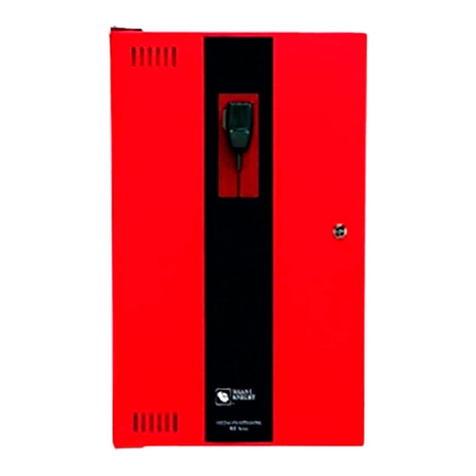
Honeywell
Honeywell Silent Knight SKE Series Installation and operation manual
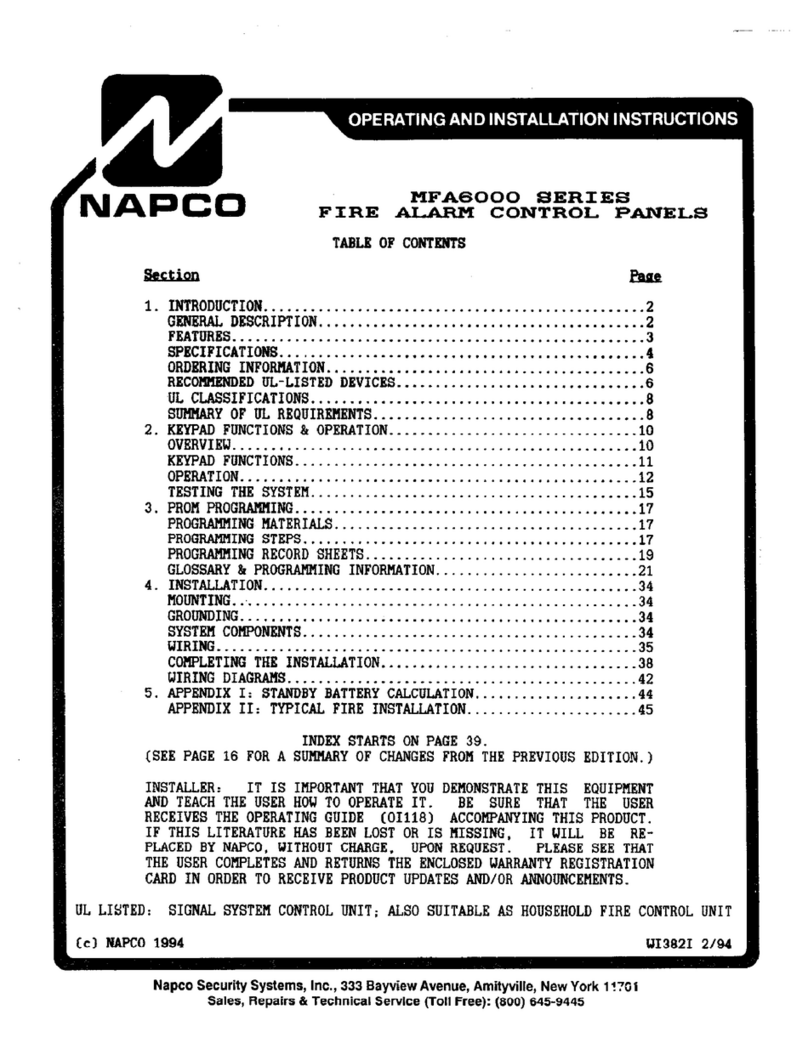
NAPCO
NAPCO MFA6000 Operating and installation instructions

EAD
EAD LP-LPD quick start guide

Biamp
Biamp TEC-X 1000 Installation & operation guide
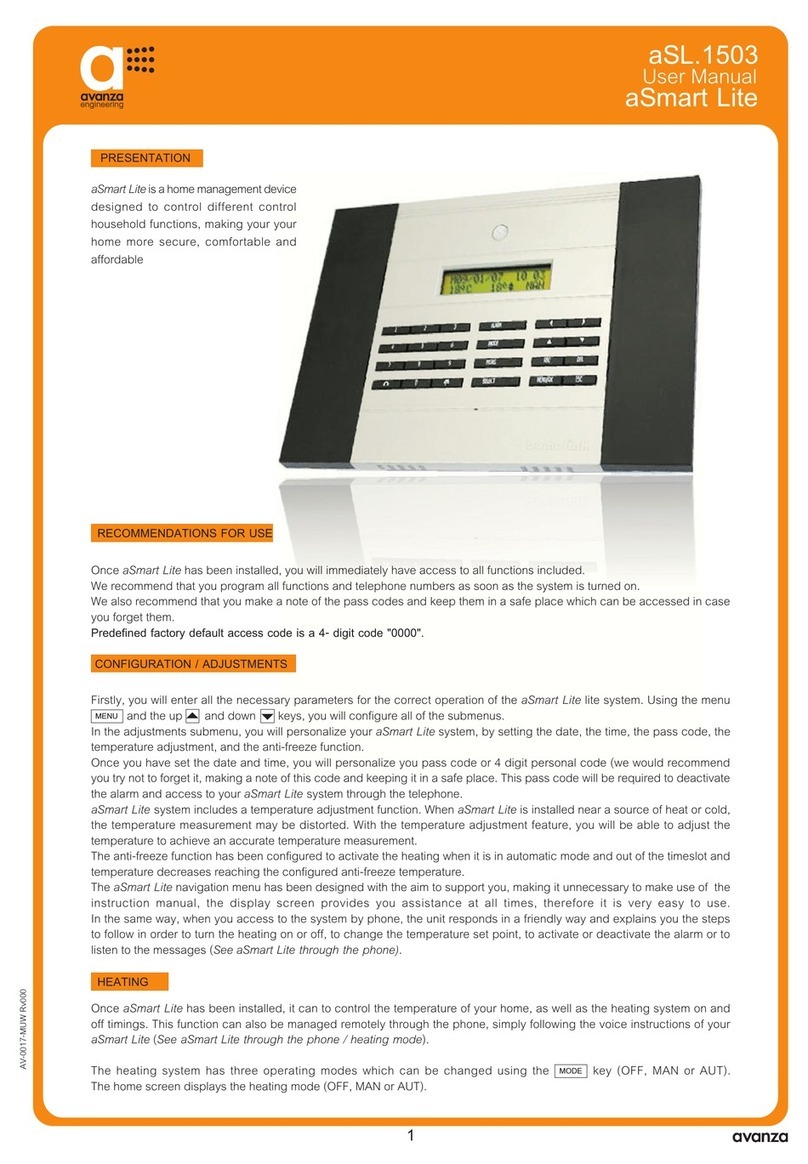
Avanza
Avanza aSL.1503 aSmart Lite user manual
